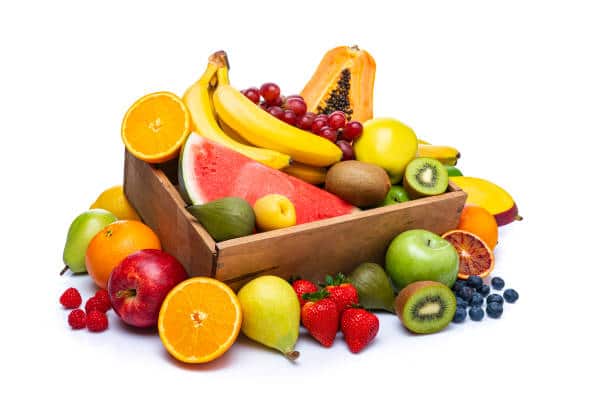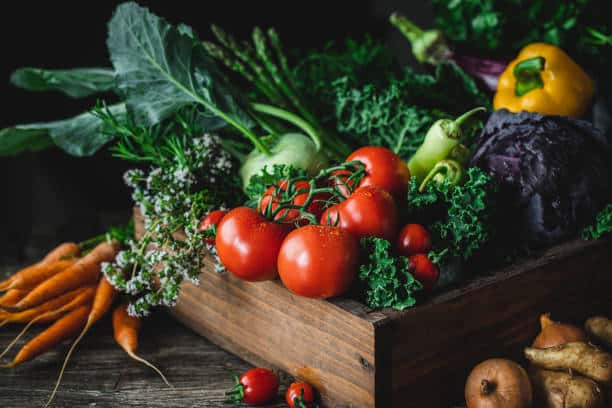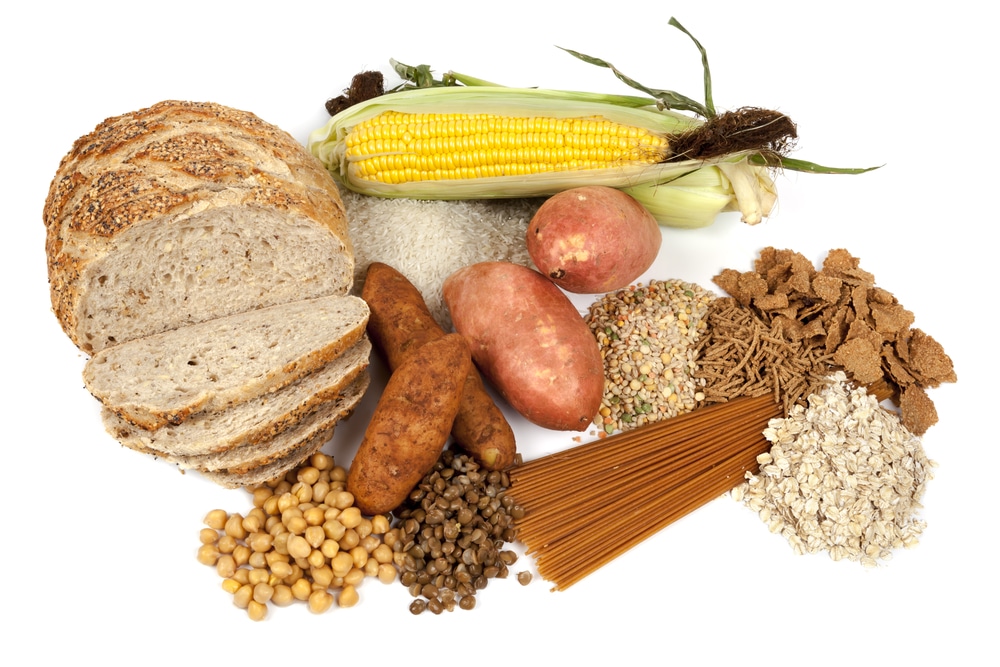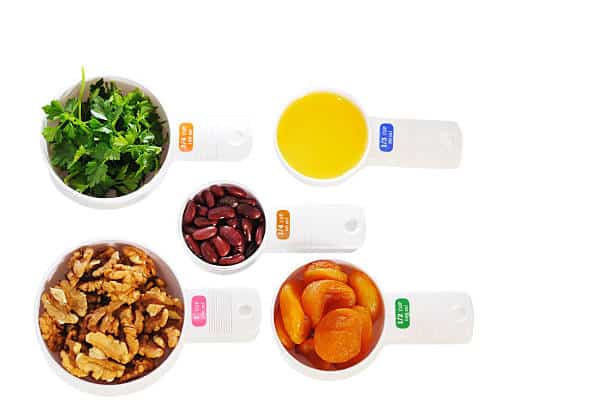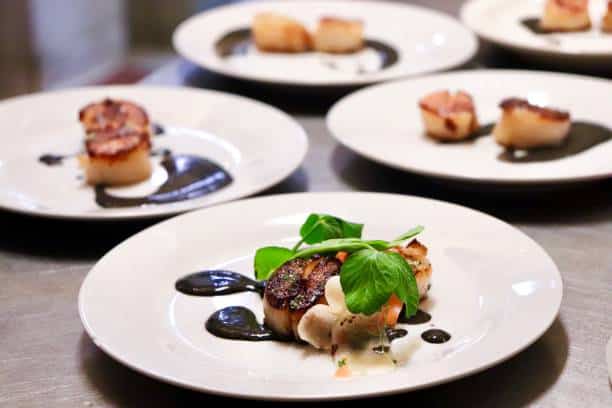Contents
- Eating and Mealtimes in Spanish
- Fruit in Spanish
- Vegetables in Spanish
- Staple Foods in Spanish
- Herbs and Spices in Spanish
- Meat and Dairy in Spanish
- Cooking Tools in Spanish
- Preparing Ingredients in Spanish
- Measurements in Spanish
- Cooking Words in Spanish
- Flavors in Spanish
- Other Spanish Food Words
- Why Learn Spanish Through Cooking
- How to Learn Spanish Through Cooking and Eating
- And One More Thing…
110+ Useful Food Words in Spanish

Food is the heart of culture, especially Spanish culture. As Spanish language learners, we grow closer to the Spanish language and Hispanic culture by learning foods in Spanish and cooking vocabulary.
The Spanish food vocabulary provided here was hand-picked to give you an authentic taste of life in Spanish-speaking regions of the world. It will also help you navigate talking about food and even being able to cook recipes in Spanish.
Download: This blog post is available as a convenient and portable PDF that you can take anywhere. Click here to get a copy. (Download)
Eating and Mealtimes in Spanish
Here are some of the most common words that you will see relating to general eating and mealtime topics:
Meals
Verbs about food
- Comer — To eat
- Beber — To drink
- Desayunar — To have breakfast
- Almorzar — To have lunch
- Cenar — To have dinner
- Estar lleno — To be full
- Tener hambre — To be hungry
- Cocinar — To cook
- Preparar — To prepare
- Servir — To serve
- Probar — To taste
- Masticar — To chew
- Tragar — To swallow
- Picar — To snack
- Compartir — To share
- Hornear — To bake
- Freír — To fry
- Asar — To roast
- Hervir — To boil
- Mezclar — To mix
- Revolver — To stir
Fruit in Spanish
Traveling throughout Latin America you are bound to stumble across many a strange and mysterious fruit. Here are some common words for fruit in Spanish, whether you know the fruit or not:
- Fruta — Fruit
- Manzana — Apple
- Naranja — Orange
- Limón — Lemon
- Maracuyá — Passionfruit
- Piña — Pineapple
- Banana — Banana
- Fresa — Strawberry
- Mango — Mango
- Coco — Coconut
- Pera — Pear
- Uva — Grape
- Fresa — Strawberry
- Melón — Melon
- Sandía — Watermelon
- Cereza — Cherry
- Limón — Lemon
- Kiwi — Kiwi
- Damasco — Apricot
Vegetables in Spanish
Vegetales is a commonly used word to say “vegetables” in spoken Spanish, but verduras (vehr-doo-rahs) is the more technically correct term.
- Vegetales — Vegetables
- Zanahoria — Carrot
- Ají — Chili pepper
- Lechuga — Lettuce
- Cebolla — Onion
- Pimiento — Pepper
- Tomate — Tomato
- Papa — Potato
- Espárrago — Asparagus
- Espinaca — Spinach
- Brócoli — Broccoli
- Coliflor — Cauliflower
- Calabaza — Pumpkin / Squash
- Calabacín — Zucchini
- Pimiento — Bell Pepper
- Berenjena — Eggplant / Aubergine
- Pepino — Cucumber
Staple Foods in Spanish
Be prepared to find these ingredients in any Latin American or Spanish household:
- Maíz — Corn
- Arroz — Rice
- Frijoles — Beans
- Harina — Flour
- Lentejas — Lentils
- Papas — Potatoes
- Plátano — Plantain
- Yucca — Cassava root
Herbs and Spices in Spanish
Here is where the distinctive flavors of Hispanic cooking originate.
- Albahaca — Basil
- Laurel — Bay leaf
- Canela — Cinnamon
- Comino — Cumin
- Jengibre — Ginger
- Orégano — Oregano
- Pimienta — Pepper
- Sal — Salt
- Romero — Rosemary
- Tomillo — Thyme
- Perejil — Parsley
- Cilantro — Cilantro / Coriander
- Eneldo — Dill
- Menta — Mint
- Nuez moscada — Nutmeg
- Azafrán — Saffron
Meat and Dairy in Spanish
These products are often the main event of the meal, despite the tower of rice and beans on the plate.
- Carne — Red meat
- Carne de res — Beef
- Pollo — Chicken
- Carne de cerdo — Pork
- Chuleta — Pork chop
- Jamón — Ham
- Salchicha — Sausage
- Tocino — Bacon
- Chorizo — Chorizo
- Cordero — Lamb
- Pescado — Fish
- Huevo — Egg
- Leche — Milk
- Mantequillla — Butter
- Queso — Cheese
- Yogur — Yogurt
- Crema — Cream
- Helado — Ice Cream
- Leche condensada — Condensed Milk
Cooking Tools in Spanish
Knowing how to refer to these will help you navigate your way around the kitchen as you follow a new recipe.
- Tenedor — Fork
- Cuchillo — Knife
- Cuchara — Spoon
- Batidor — Whisk
- Espátula — Spatula
- Sartén — Frying pan
- Olla — Pot
- Licuadora — Blender
- Tetera — Kettle
- Tostadora — Toaster
- Tabla de cortar — Cutting board
- Sartén — Pan / Skillet
- Cacerola — Saucepan
- Olla — Pot
- Espátula — Spatula
- Batidora — Mixer / Blender
- Colador — Strainer / Colander
- Cucharón — Ladle
- Cucharas de medir — Measuring spoons
Preparing Ingredients in Spanish
These are the first and most crucial steps to any recipe.
- Lavar — To wash
- Pelar — To peel
- Cortar — To cut
- Picar — To chop
- Moler — To grind
- Agregar — To add
- Mezclar — To mix
- Batir — To whisk
- Combinar — To combine
- Aliñar — To dress (salad)
- Fundir — To melt
- Machacar — To crush
- Rebozar — To bread/fry
- Salpimentar — To season with salt and pepper
- Untar — To spread
Measurements in Spanish
If you want to follow a recipe properly, you need to know how much of each ingredient to use.
- Libra — Pound
- Taza — Cup
- Cucharada — Tablespoon
- Cucharadita — Teaspoon
- Onza — Ounce
- Gramo — Gram
- Miligramo — Milligram
- Litro — Liter
- Mililitro — Milliliter
- Galon — Gallon
Cooking Words in Spanish
Here are some Spanish cooking terms to use when talking about actually cooking the food.
- Calentar — To heat
- Freír — To fry
- Hervir — To boil
- Hornear — To bake
- Asar — To roast/broil
- Quemar — To burn
- Llama — Flame
- Baja la llama — Lower the temperature
- Alza la llama — Raise the temperature
- Fuego alto — High heat
- Fuego medio — Medium heat
- Fuego bajo — Low heat
Flavors in Spanish
- Dulce — Sweet
- Salado — Salty
- Picante — Spicy
- Contundente — Heavy, overwhelming
- Empalagoso — Sickly sweet
- En su punto — Cooked to perfection
- Exquisito — Exquisite
- Grasiento — Greasy
- Soso — Tasteless
Other Spanish Food Words
- Denominación de origen — Destination of origin, where the food comes from
- De temporada — In season
- Orgánico — Organic
- Transgénico — Genetically modified
- Vendimia — Vintage wine
- Degustación — Tasting
- Paladar — Palate
- Pinta — Appearance of food
- Surtido — Variety or assortment
Why Learn Spanish Through Cooking
While becoming immersed in the Spanish language and eating out at restaurants abroad, you’ll encounter an incredible diversity of Hispanic foods.
The regions of Spain alone offer a wide array of culinary styles, from rice dishes to seafood and roasted meats.
Taking all of Latin America into consideration, one can become overwhelmed trying to define the sweeping category that is Hispanic cuisine.
To really grasp Spanish culture, you can try all the different foods, whether at an authentic restaurant or making it yourself.
If you do cook something yourself, you can use the Spanish recipe to not only get the cultural experience, but practice your Spanish reading as well!
How to Learn Spanish Through Cooking and Eating
By integrating Spanish learning into your shopping, cooking, and eating habits, you infuse one more aspect of your life with your new language.
Once you begin to familiarize yourself with Spanish cooking vocabulary you’ll find many more learning tools and strategies open up to you.
Here are some ways to learn and practice your Spanish food vocabulary and cooking terms:
- Shop at a local Hispanic grocery store and practice reading Spanish labels.
- Watch Spanish food-related videos on YouTube or Spanish learning platforms. The immersive language program FluentU adds interactive dual-language subtitles and other tools to Spanish videos.
FluentU takes authentic videos—like music videos, movie trailers, news and inspiring talks—and turns them into personalized language learning lessons.
You can try FluentU for free for 2 weeks. Check out the website or download the iOS app or Android app.
P.S. Click here to take advantage of our current sale! (Expires at the end of this month)

- Make a Spanish shopping list whenever you go to the store to reinforce what you’ve learned.
- Watch Spanish language cooking shows to pick up new recipes and kitchen tricks.
- Cook a regional dish from Spain or Latin America and host a Spanish conversation night for your language partner, fellow Spanish language learners and native speakers.
While cooking styles are very variable throughout the Spanish-speaking world, the basic ingredients and preparations are strikingly similar.
Here is a great video that will introduce you to even more kitchen vocabulary:
Now that you know all this Spanish food vocabulary, there’s nothing left to do but enjoy all that Spanish food. If you intend to do so while eating out, visit our post about Spanish restaurant vocabulary for even more useful words and phrases!
¡Buen provecho! (Bon appetite!)
Download: This blog post is available as a convenient and portable PDF that you can take anywhere. Click here to get a copy. (Download)
And One More Thing…
If you've made it this far that means you probably enjoy learning Spanish with engaging material and will then love FluentU.
Other sites use scripted content. FluentU uses a natural approach that helps you ease into the Spanish language and culture over time. You’ll learn Spanish as it’s actually spoken by real people.
FluentU has a wide variety of videos, as you can see here:

FluentU brings native videos within reach with interactive transcripts. You can tap on any word to look it up instantly. Every definition has examples that have been written to help you understand how the word is used. If you see an interesting word you don’t know, you can add it to a vocab list.

Review a complete interactive transcript under the Dialogue tab, and find words and phrases listed under Vocab.

Learn all the vocabulary in any video with FluentU’s robust learning engine. Swipe left or right to see more examples of the word you’re on.

The best part is that FluentU keeps track of the vocabulary that you’re learning, and gives you extra practice with difficult words. It'll even remind you when it’s time to review what you’ve learned. Every learner has a truly personalized experience, even if they’re learning with the same video.
Start using the FluentU website on your computer or tablet or, better yet, download the FluentU app from the iTunes or Google Play store. Click here to take advantage of our current sale! (Expires at the end of this month.)

